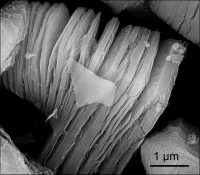Research Activities
The complex elastic modulus is measured as a function of temperature (1-1000 K) exciting resonances (0.1 -100 kHz) of samples of any solid material in order to obtain information on: any type of phase transitions; mobility and aggregation of ions, point and extended defects; small polarons; domain walls and structural, electric, magnetic excitations or inhomogeneities. With non—conducting materials the measurements are usually complemented with the dielectric ones (see LAB-DS). It is possible to treat the samples at high temperature in UHV o controlled gas atmosphere/flux for annealing, degassing, hydrogenation, oxygenation, reduction
Phase transitions and ionic mobilities in perovskites

Metal-organic perovskites for photovoltaics
In combination with dielectric measurements, information has been obtained on the phase transitions and the dynamics of the MA molecules in the metalorganic perovskite MAPbI3 and FA in FAPbI3.
The α→β transition consists mainly of a rotation of the PbI6 octahedra about the c axis and therefore gives rise to a steplike softening of the elastic modulus. The weak dielectric response (not shown in Fig. 2) demonstrates that a ferroelectric component is absent or extremely weak, contrary to many reports. Based on the Landau theory, it has been shown that a strong coupling between octahedral tilting and the reorientation of the polar MA molecules can depress the temperature of the ferroelectric transition and prevent its occurrence. Also the β→γ transition involves rotations of the octahedra, but the fact the elastic modulus rises, and far above the value in the α phase, indicates an important contribution from the freezing of the rotations of the MA molecules. Much of this freezing occurs gradually with thermally activated and strongly correlated dynamics, as demonstrated by the anelastic relaxation peak that shifts to higher T with increasing f and has a broad shape.

Piezoelectric response of ferroelectric materials from elastic measurements

Instrumentation
Collaborations
- Scientific collaboration and co-participation to projects with Floriana Craciun, CNR-ISM (Tor Vergata) for dielectric measurements
- Scientific collaboration and co-participation to projects with the group of Carmen Galassi, CNR-ISTEC (Faenza) for the preparation and characterization of ceramic ferroelectric samples
- Scientific collaboration with Francesco Trequattrini, Dip. Fisica Università di Roma “La Sapienza” for anelastic relaxation measurements
- Scientific collaboration and co-participation to projects with Annamaria Paoletti, Gloria Zanotti, Patrizia Imperatori, Giovanna Pennesi, CNR-ISM (Montelibretti) for the preparation of samples of hybrid organic-inorganic perovskites for photovoltaic and with ferroelectric properties
- Scientific collaboration with Barbara Paci e Amanda Generosi, CNR-ISM (Tot Vergata) for XRD analysis of hybrid organic-inorganic perovskites
- Scientific collaboration and co-participation to projects with il gruppo di Victor Fruth, Institute of Physical Chemistry, Romanian Academy, Bucharest, Romania, for the preparation and characterization of ferroelectric hybrid organic-inorganic and polymeric materials
- Scientific collaboration and co-participation to projects with the group Paulo Sergio da Silva Jr., Dip. Fisica, UFSCar, São Carlo (SP), Brazil, for anelastic measurements, characterization and preparation of ceramic samples.
- Start of scientific collaboration with prospective of common projects with Oktay Aktas, State Key Laboratory for Mechanical Behavior of Materials & School of Materials Science and Engineering, Xi'an Jiaotong University, China for studying the influence of defects on the ferroelectric fluctuations in the paraelectric phases of titanate perovskites.

 MXene consists of metallic layers, that can easily slide with respect to each other like sheets in reams. A phase
MXene consists of metallic layers, that can easily slide with respect to each other like sheets in reams. A phase “Elastic precursor effects during the Ba1-xSrxTiO3 ferroelastic phase transitions”, published in Physical Review Research, is the result of a collaboration
“Elastic precursor effects during the Ba1-xSrxTiO3 ferroelastic phase transitions”, published in Physical Review Research, is the result of a collaboration English (UK)
English (UK)  Italiano (Italia)
Italiano (Italia)